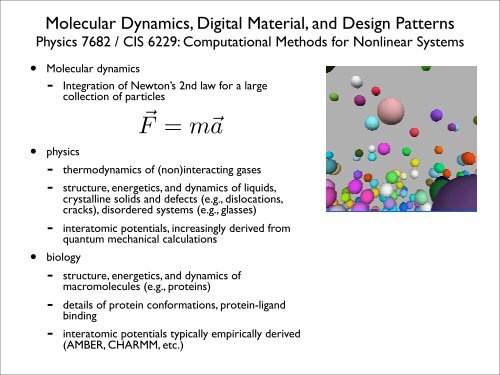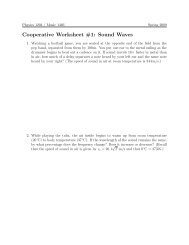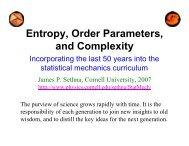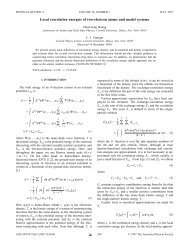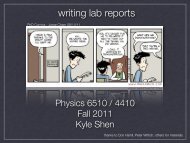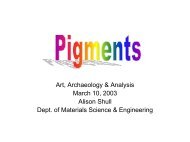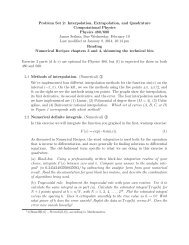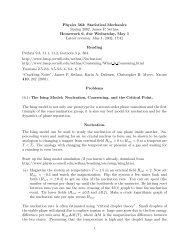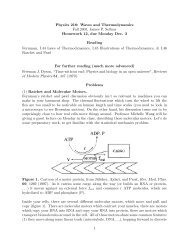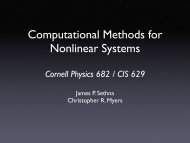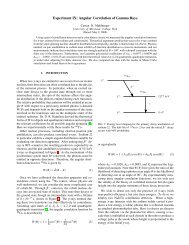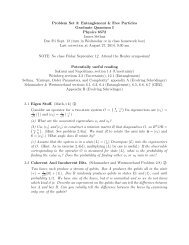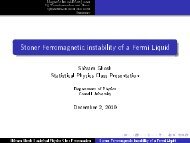Molecular dynamics, DigitalMaterial, and design patterns
Molecular dynamics, DigitalMaterial, and design patterns
Molecular dynamics, DigitalMaterial, and design patterns
Create successful ePaper yourself
Turn your PDF publications into a flip-book with our unique Google optimized e-Paper software.
<strong>Molecular</strong> Dynamics, Digital Material, <strong>and</strong> Design Patterns<br />
Physics 7682 / CIS 6229: Computational Methods for Nonlinear Systems<br />
• <strong>Molecular</strong> <strong>dynamics</strong><br />
- Integration of Newton’s 2nd law for a large<br />
collection of particles<br />
⃗F = m⃗a<br />
• physics<br />
- thermo<strong>dynamics</strong> of (non)interacting gases<br />
- structure, energetics, <strong>and</strong> <strong>dynamics</strong> of liquids,<br />
crystalline solids <strong>and</strong> defects (e.g., dislocations,<br />
cracks), disordered systems (e.g., glasses)<br />
- interatomic potentials, increasingly derived from<br />
quantum mechanical calculations<br />
• biology<br />
- structure, energetics, <strong>and</strong> <strong>dynamics</strong> of<br />
macromolecules (e.g., proteins)<br />
- details of protein conformations, protein-lig<strong>and</strong><br />
binding<br />
- interatomic potentials typically empirically derived<br />
(AMBER, CHARMM, etc.)
<strong>Molecular</strong> Dynamics module<br />
• Not usual hints+fill-in-the-missing<br />
code structure<br />
- focused more on use of existing<br />
package (Digital Material) <strong>and</strong><br />
analysis of simulation data<br />
- uses VPython (visual) for<br />
animated graphics<br />
• Exercises<br />
- Perfume Walk: r<strong>and</strong>om walk due<br />
to collisions<br />
- Pressure: emergence of pressure<br />
from collisions<br />
- Equilibration: convergence to<br />
equilibrium from nonequilibrium<br />
state<br />
- Exponential Atmosphere:<br />
thinning of atmosphere under<br />
gravity<br />
- Pair Distribution Function:<br />
positional correlations in gas,<br />
liquid, solid<br />
Perfume Walk<br />
Equilibration<br />
Pressure<br />
Pair Distribution<br />
Exponential Atmosphere
Digital Material package<br />
• Grew out of a multiscale materials modeling effort (Sethna, Myers, et al. 1998-2002)<br />
- emphasis on investigating the structure <strong>and</strong> <strong>dynamics</strong> of defects in crystalline<br />
<strong>and</strong> polycrystalline materials relevant for deformation <strong>and</strong> failure<br />
➡<br />
dislocations, dislocation tangles, grain boundaries, cracks<br />
- emphasis on construction <strong>and</strong> manipulation on nontrivial, heterogeneous defect<br />
geometries <strong>and</strong> coupling to coarse-grained models (e.g., finite-element analysis)<br />
- original code in C++ with minimal Python wrapper; ported to Python for Phys<br />
682 / CIS 629 by Sethna
Class Diagram: interactions among classes in OO code
Class Diagram: interactions among classes in OO code<br />
CRM, “Software systems as complex networks...”, Phys. Rev. E (2003)
Design <strong>patterns</strong><br />
• Object-oriented <strong>design</strong> methodology for building code that can easily incorporate changes<br />
- collaborations among sets of classes/objects to encapsulate highly variable pieces<br />
- different <strong>patterns</strong> encapsulate different types of variability, e.g.,<br />
- factories address variability in the construction of objects<br />
- observers address variability in views/analyses of a central data repository<br />
- strategies address variability in algorithms<br />
- adapters address variability in class/object interfaces<br />
- emphasis on having many smaller objects working together (more reconfigurable), rather<br />
than more specialized <strong>and</strong> monolithic pieces that are harder to change<br />
- initially catalogued in the well-known book by Gamma et al. (“Gang of Four”, of GoF)<br />
• Design <strong>patterns</strong> in Digital Material<br />
- ListOfAtoms: efficient collections of atoms<br />
- Initializers <strong>and</strong> transformers: decoupled algorithms for manipulating structure<br />
- Movers: decoupling structure from <strong>dynamics</strong> (use different algorithms)<br />
- Observers: decoupling analysis from <strong>dynamics</strong> (generic Update() interface)<br />
- Boundary conditions: decoupling enforcement of boundary conditions from <strong>dynamics</strong><br />
- NeighborLocators: decoupling structure from force computation
Gravity cluster<br />
gravityPotential = GravityPotential(g=g)<br />
LennardJonesPotential = LennardJonesCutPotential()<br />
potential = CompositePotential([gravityPotential,<br />
LennardJonesPotential])<br />
boundaryConditions = ReflectiveBoundaryConditions(L)<br />
neighborLocator = SimpleNeighborLocator(LennardJonesPotential.cutoff,<br />
boundaryConditions)<br />
atoms = TriangularSphericalClusterListOfAtoms(<br />
R=R, center=[L/2., L/2.], temperature=T,<br />
radius=LennardJonesPotential.latticeSpacing/2.0)<br />
displayObserver = VisualDisplayAtomsObserver(atoms,L)<br />
energyObserver = EnergyObserver(potential, neighborLocator,<br />
boundaryConditions)<br />
observers = [displayObserver, energyObserver]<br />
mover = RunVelocityVerlet;<br />
sys = MDSystem(L, atoms, observers, neighborLocator,<br />
boundaryConditions, potential, mover)


